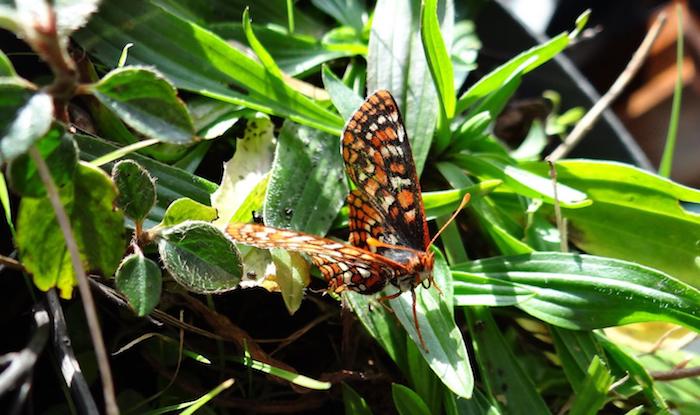 The inhabitants of little world evolve very quickly, making them nimble in the Anthropocene. That’s good, because most things on Earth are little.
The inhabitants of little world evolve very quickly, making them nimble in the Anthropocene. That’s good, because most things on Earth are little.
It is because I have some faith in the richness of the little world’s genetic raw material and the blind, brute power of evolution that I am less worried about “invasive” plants than I used to be. Case in point: the American Black Cherry (Prunus serotina) has been invading Western Europe since the early 20th century. It only took 100 years for the insects to adapt to it and begin eating it. Ecologist Menno Schilthuizen found over 64 species—including some finicky “specialist species” predicted to shun the novel—gnawing on it in a 2016 study in PeerJ. (Cool short video about the experiment here.)
This week, in Nature, we are treated to another tale of insect adaptability in a humanized world. This is a really fantastic longterm experiment with a long and painstakingly collected data set—and here is the story the data tell…
In one meadow in Nevada, the Edith’s checkerspot Butterfly (Euphydryas editha) began to eat and lay its eggs on the introduced narrow-leaved plantain (Plantago lanceolata). Indeed, those that chose the new plant instead of their old standby—maiden blue eyed Mary (Collinsia parviflora)—had higher numbers of surviving offspring because the plantain lives longer and is reliably there to nourish emerging larvae. Starting in the 1980s, butterflies in this meadow began to prefer to lay their eggs on Plantago, a preference that was genome-deep. By 2005, every single female the scientists caught was a convert.
So far so good. The world changes and its species adapt. Nature is perhaps not as fragile as we once supposed. The butterflies were even doing better! But the study’s authors point out that what humanity giveth, humanity usually taketh away. To University of Plymouth ecologists Michael Singer and Camille Parmesan, dependence on a human world is the setup to a inevitable tale of woe. No species should hitch their carts to our grim chariot of doom.
They write: “We predicted that if this trend continued the insects could endanger themselves, because the availability of Plantago to butterflies is controlled by humans, who change land management practices faster than butterflies evolve. Here we report the fulfillment of this prediction. The butterflies abandoned Collinsia and evolved total dependence on Plantago. The trap was set. In 2005, humans withdrew their cattle, springing the trap.”
You’ve heard the idea that a butterfly flapping its wings in Brazil could cause a tornado in Texas. Here, a single human life stilled the flap of a thousand butterflies. When rancher Harry Schneider died, his meadow was sold and the cattle went away. Grass grew tall, shading and tangling the Plantago. The butterflies need a bit of bare ground near their host plants to soak up sun; their new hosts were now all enmeshed in the cool shade of tall grass. There were unshaded Collinsia plants available at the meadow’s edge, but the butterflies had forgotten the old ways. Mating failed and after fruitless searches in 2008, 2009, 2010 and 2012, the team concluded that “the Schneider population was extinct.”
This is the essential story that the authors seem to want to tell, and the conclusion they draw is right there in the title of the paper: “Lethal trap created by adaptive evolutionary response to an exotic resource.” Humanize at your peril.
And yet there are hints in their account that adaptation is not always a trap.
The butterflies in the meadow actually died because humans stopped working the land and let it go wild. The meadow flourished and became green and lush. The ecologists write that “increased lushness caused by the abandonment of traditional land management in Europe has caused ground-level cooling, which has resulted in butterfly population declines and local extinctions.” So…butterflies have historically done well in our anthropogenic landscapes, with their bare bits of earth good for sunbathing.
And then there’s the fact that if you return to that Nevada meadow today, you’ll find Edith’s checkerspots sailing on the breeze again. Once the fertilizer from all that cow manure ran out, the lushness decreased. Enterprising butterflies from someplace else re-colonized. This new group prefers the old host, the maiden blue eyed Mary—for now. This happy ending surprised the researchers. “Our mindset in 2014 was simply to reconfirm the extinction, and we were very surprised to find larvae,” they write. To be fair, ecologists are often unprepared for good news.
They conclude, “The ecotypic variation and rapid evolution of this species augur well for its resilience to environmental fluctuations, whether natural or anthropogenic.” So why was the title of the paper not something like “Adaptive evolutionary response to an exotic world may save the butterflies yet” rather than a chilling reference to a lethal trap?
Maybe we are afraid to admit that despite our vast destructiveness, the little world—at least—is often nimbler than the bombs we throw at it.
We shouldn’t’ be. Acknowledging the power of evolution to see living things out of all kinds of ecological jams doesn’t obviate our responsibility to stop wantonly disregarding other species. We need not exaggerate nature’s fragility to make the case that we should stop taking a sledgehammer to it.
Photo: An Edith’s checkerspot butterfly (Euphydryas editha) on a narrow-leaved plantain (Plantago lanceolata). Credit: Michael C. Singer/University of Plymouth
Yup…those butterflies will prolly be around after human civilization has collapsed.